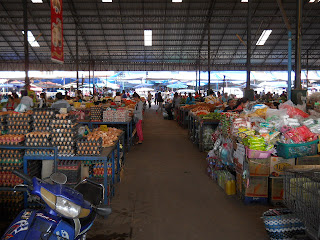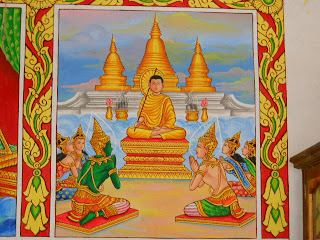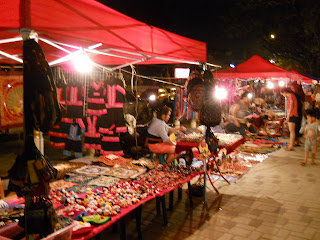
Lao people would call Vientiane as Wiang Chan which is also the capital city of Laos located towards northeast of the Mekong River.
During the 16th century,Luang Prabang was the traditional capital.
In 1778,Vientiane was under the control of the Siamese and in 1945 the Japanese had a brief occupation of the city.
On the whole it was the French administrative capital between 1899 till 1953.
Wattay Domestic and International Airport(code: VTA,ICAO code:VLVT) is just less than 5km towards the west of the city off Thanon Luang Prabang.
Taxi coupon rate from airport to city is USD6 and minibus or tuk-tuk were also available near the vehicle parking lot.
The airport(lao:deun bin) is located in the Sikhottabong District which is one of the nine districts in Vientiane.
The other districts in Vientiane Prefecture province are:Chanthabuly, Hadxaifong, Mayparkngum, Naxaithong, Sisattanak, Xaysetha, Xaythany and Vientiane.
Sights along Thanon Luang Prbang Road:-Wat Tai Yai,Kok Po Market,Wat Tai Noy,Wat Oup Moung,Wat Khounta.
Nice seafood restaurants like Khungphung T2 is along Asiane Road which leads to the Northern(lao:neua) Bus(lao:lod may) Terminal(lao:khiu).
Nong Duang Food Garden near bus terminal has a very serene surrounding with greeneries and fish ponds.
Having seafood lunch on a floating hut beside the pond and enjoying your afternoon beer Lao will give you a romantic feeling of a village style experience. It's a family run business and their main specialty is fresh fishes from the pond.
Most of the restaurants along Asiane Road are popular hunt among the locals and can be quite packed at times.
Opposite Kok Poh Market and Savanah Restaurant is a road should be Rue Wattayai that leads to Xang Chieng Market (San Jiang Shopping Complex) which are the China products village.

Map showing the area beyond the airport area which is also the busiest bus route to the north of Laos.
The trunk roads run parallel to the Mekong River.
Ban Sikhay village to Ban Thongpong area is quite a populated suburb of Vientiane.
As noticed there were Sikhay market and Nongnieu market as well as a small bus terminal that covers the Sangthong District area.
Sangthong District(about 70km west of Vientiane) is one great place off the beaten path to see the beautiful countryside and see the lifestyle of the villagers.
There were 10 sub-districts namely Phonehong(capital), Thoulakhom, Keo-Oudom, Kasy, Vangvieng, Feuang, Xanakham, Mad, Hinhurp and Viengkha
Sangthong is one of the 47 poorest district in Laos.
Agriculture is the main activity of the district and the socio-economic status of the local residents were gradually improving with the good road infrastructure.
Before that it took two hours to reach but now less than an hour. Bamboo and banana tree handicrafts were produced by the ethnic minority groups in the district.
Perfect place for outdoor activities:Phou Khao Khouay National Protection Area and Tad Leuk Park suitable for camping but crowded.
Tad Xay and Pha Xay are two beautiful cascading waterfalls in the area. Tad Xet has panoramic view of the mountains.
Getting there:local transport to small town of Thabok at km90.
Western part reached via Ban Napheng.
Wild pig jaws were one of the prohibited items to be exported including the elephant tusks.
Eurasian Wild Pig is found throughout Laos.
Pigs are very important food for the large wild cats - Tiger and Leopard.
As a managed species, they are also important for village subsistence but are illegally traded from the wild to supply meat for urban markets and restaurants.
This is having a negative effect on both large wild cats and subsistence villages.
Huge Asian elephant molar also on the list of export offence.
Nam Et-Phou Louey is the largest National Protected Area in North-east Laos PDR covering an area of about 6,000 square kilometre.
It covers 7 districts and three provinces (Houaphan, Luang Prabang and Xieng Khouang provinces).
The NPA is mostly hilly or mountainous and is the source of many rivers. It is named after its two main features, the Nam Et River and Phou Louey Mountain (“Forever Mountain”).
The area has primary forest rich in flora and fauna including many endangered wildlife. This is truly an evergreen virgin jungle and the Nam Et Phou Louey is a mountainous area being the source of many major rivers including Nam Nern, Nam Khan, Nam Et, Nam Seuang, and Nam Seng.
In addition there are many tributaries, which contribute significantly to the livelihoods of local people. The main importance of rivers to villagers relate to transportation, fishing, household water supply and irrigation amongst others.
Laos used to be known as 'Land of Million Elephants' but mankind is slowly overtaking the rule of law of the jungle under the disguise of development.
The habitats of the wild elephant will be threatened through hunting for use in the ivory trade.
From the Northern Bus terminal,most 'songtheaws' will transport passengers via the police camp traffic light junction passing by Statue of King Fa Ngum monument beside a park and turn into Setthatirah Road which will be their specific stop for a fare of 10,000 kips.
Novotel Hotel,Mekong Hotel and Parkview Residence Apartment were easily recognised landmarks along the way.
Near the junction of Khoun Bulom and Setthatrirah Road is the Cindamay Guest House,behind a petrol station.
Room rates about 80,000 kips Tel:(856021) 262 125.
Chou Anou Road is the Chinatown area while across the junction is Tongkhankham Road where there is very big market with diversified variety of wet and dry sundy goods.

View of Tongkhankham Market in central Vientiane.
A systematic market divided into sections like groceries,vegetables,seafood products and wholesale stores whereas clothings,praying peripherals,sandals,handicrafts,general merchandise were in small shoplots.
A few food stalls were also aligned in one corner. Most of the expatriates communities would come here to do their daily shopping.
This is Lane Xang Avenue in Chantabouly District with a good view of Patuxai Monument.
Photo taken at road junction with the Presidential Palace behind me.
Distance from Setthatirath Road is about 2km. Centrally located in the main artery of Vientiane surrounded by many financial institutions such as the ANZ Bank,Joint Development Bank,Mitsui Sumitomo Insurance,Lao-Viet Bank and Vietcom Bank.
Government agencies like Tourist Information Office,Judiciary Department Ministry of Justice,Forestry Department,Ministry of Education,Lao Telecom and General Post Office. Hotels in the vicinity include Lane Xang Pricess Hotel,Royal Dokmaideng,Khamkoun Hotel,Hotel Ekalath Metropole,Sengphachanh Hotel.

Area in circle is the heart of Vientiane showing the city's central bus terminal where this map is available for viewing.
Talat Salo Mall is just across the bus terminal. Moving on behind the bus terminal were many stalls selling garments and other general merchandise.
It is linked to the Khoun Din Market. You'll never notice this market as there won't be any sign unless you walk through a very narrow alley at the far end of the food stalls near where the washroom is at the bus terminal.
Patuxai Monument also known as a Victory Monument honouring the struggle for independence from France.
The arch has resemblance to that of Arc de Triomphem in Paris.
A beautiful park surrounded the monument and during the night the place looked glittering like a jewel and visitors would gather around the musical fountain.
This is one of the most popular tourist must see destinations in Vientiane.
The Patuxay Monument opening hours is from 08:00 till 17:00 hours.

The Black Stupa is located beside the American Embassy and no photography is allowed beside the embassy's road.
Only through Chantha Khoummane Road area can the photographs be taken.
Old legends says a seven headed dragon protected the people of Vientiane from Siamese invaders during the 1828 war and the dragon is believe to be hidden under the That Dam Stupa.
This conical shape is also incorporated into the That Luang Stupa.
Beyond Patuxay Monument is Kaysone Phomvihane Road where you have the Thai Consulate,World Bank,residence of late Prince Suphanouvong,Lao PDR Army Museum,transmission tower Phonkhenh,Lao-American College Campus.
Along Singha Road which has the most government agencies will lead to the main icon of Laos,the Pha That Luang Stupa which is a gold covered large Buddhist Stupa and a focal point of the annual That Luang Festival in early November.

Wat Hong Kai Keo is a Vietnamese Buddhist Temple off New Hong Kai Keo Road which is about 15 minutes walk from Patuxay Monument.
Most Vietnamese people stay around this area. A five level element pagoda with a Buddha statue on the apex. Bottom level represents earth,then comes to metal which in turn produces water,then wood and finally fire.

Had lunch at this vietnamese restaurant.
My hostel mate Cuong usual dining place and we brought along a Taiwanese traveller whom we met at the central bus terminal.

Mekong River area has a lot of restaurants and bars. Mahasot Hospital,Hotel Donechan Palace, Wat Phye,Wat That Kao, Wat Paxay,Cambodian,Indian,Poland,Korean,Myanmar and German Embassy all located near the river.
Night bazaar at the newly built Mekong Riverfront in Vientiane.
Stalls selling souvenirs,silk products,handicrafts and garments were being set up during the night. Scene is quite similar to that in Luang Prabang.
Quite recently opened Korean Restaurant along Khoun Bulom Road which is opposite the front entrance of Chou Anouvong National Stadium.
During the night along the open airspace infront of the restaurant were the night food bazaar and there were many stalls selling cheap Lao food.

Further south of the Mekong River along Thadeua Road you have the UNICEF,Muang Lao China Hotel,Wat Nak Yai,Vietnam Traditional Massage,Vientiane Bowling Centre,4km Restuarant,Mekong Restaurant,Europ Steak House,Anna Restaurant,Democratic Peoples Republic Korea,Russia and China Embassies.
I happened to stumble into one restaurant with a large jar with content looked like a primate as its has a toe similar to the human.
A huge iguana is also kept in the jar.
 Stall at Tongkhankham market selling the prasat pheung which were decorated with chrysanthemum real flowers.
Stall at Tongkhankham market selling the prasat pheung which were decorated with chrysanthemum real flowers.























































